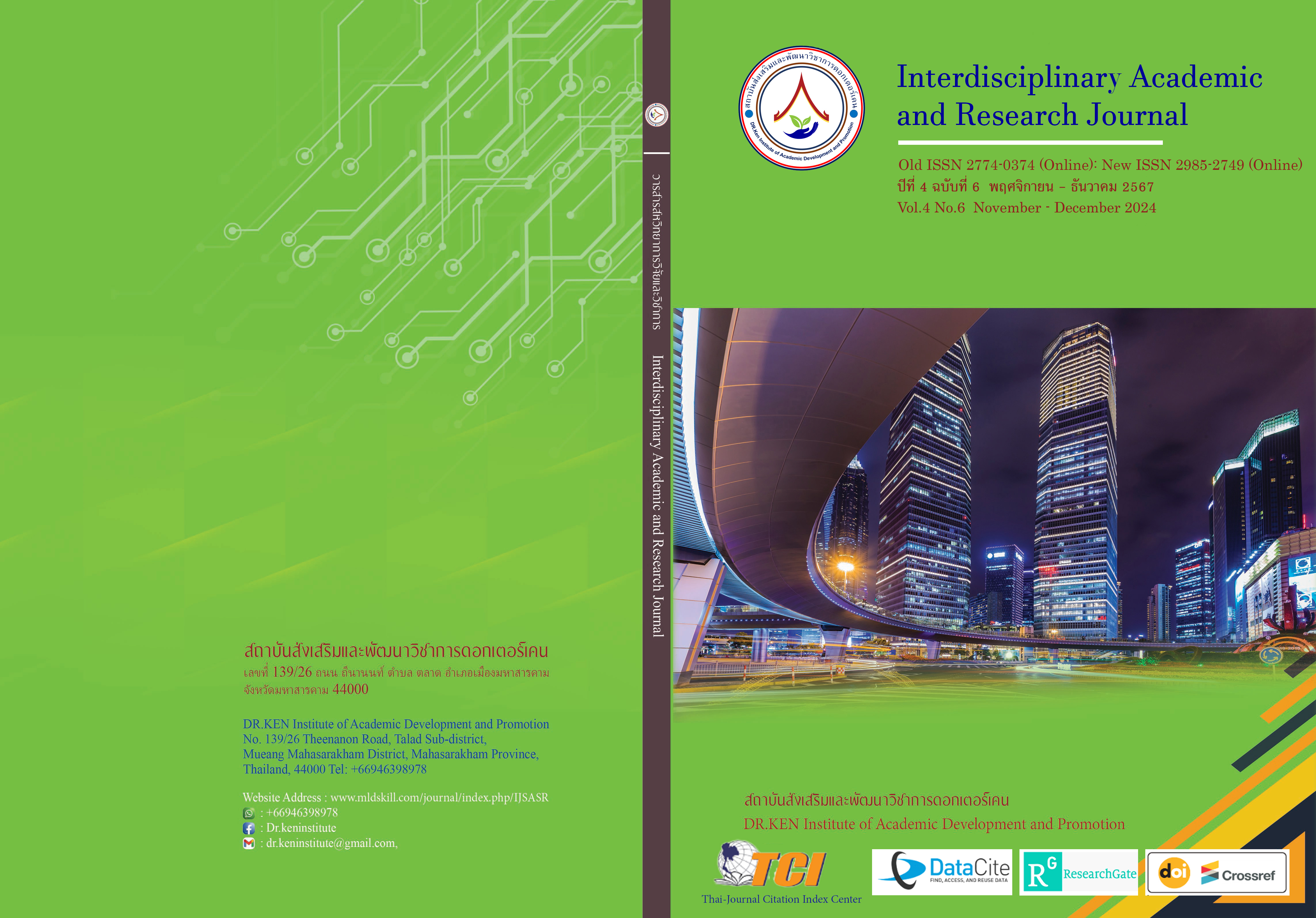The Intention to Purchase Functional Food from Rice Bran Protein, The Moderation of Consumers' Perception of Innovation Food in Bangkok
DOI:
https://doi.org/10.60027/iarj.2024.279423Keywords:
Functional Foods, Rice Bran Protein, Theory of Planned Behavior, Innovation PerceptionAbstract
Background and Aims: In order to understand how perceptions of food innovation affect consumers' intentions to purchase rice bran protein functional foods, it is necessary to evaluate consumer awareness, perceived benefits, price sensitivity, taste, marketing, and ethical concerns. Demographics, trust, perceived risk, cultural influences, communication channels, and prior experiences are important factors. Comprehending these domains is imperative for the efficacious introduction and endorsement of novel functional foods in Bangkok. The objectives of this research are 1) to study demographic factors and health behaviors. 2) to study the 4Ps marketing factors that affect the intention to purchase functional food from rice bran protein 3) to study the effect of perception of food innovation in governance The relationship between patterned behavior and intention to purchase functional food from rice bran protein.
Methodology: This paper was conducted by the researcher to collect data. Using random sampling from questionnaire collection of 420 people in Bangkok. It was used to analyze the frequency distribution, percentage, average standard deviation. And multiple regression analysis of statistical results.
Results: The research findings indicate that demographic factors such as age, education level, occupation, and monthly income significant difference health’s behaviors. Specifically, consumers with different ages, education levels, occupations, and income levels exhibit significantly different health’s behaviors at a statistical significance at the 0.05 level. However, there was no significant difference in health’s behaviors between consumers of different genders at the 0.05 statistical significance level. The marketing mix (4Ps) Product and Price significantly affect the intention to purchase functional foods made from rice bran protein statistically significant at the 0.05 level. However, Place and Promotion were non-significant effect on the intention to purchase functional foods made from rice bran protein.
Conclusion: The results of the study show that while gender has no effect on health behaviors, demographic factors like age, education, occupation, and income do. Furthermore, while place and promotion have no effect on the intention to purchase rice bran protein functional foods, the product and price aspects of the marketing mix do.
References
กันต์วิรุฬห์ พลูปราชญ. (2561). พฤติกรรม และความต้องการทางด้านผลิตภัณฑ์อาหารเพื่อสุขภาพของผู้บริโภคในเขตกรุงเทพมหานคร. วิทยาลัยดุสิตธานี, 14(2), 307-322.
เกตุวดี สมบูรณ์ทวี และ จักรี กลิ่นชั้น (2564). การตัดสินใจซื้อเครื่องดื่มสุขภาพประเภทเวย์โปรตีนของกลุ่มเจเนอเรชั่นวายโดยประยุต์ใช้ทฤษฎีตามแบบแผน. วารสารมหาวิทยาลัยคริสเตียน, 27 (4),103-119.
ฉันทิดา สถาปน์เงิน, ธัญนันท์ บุญอยู่, สุมาลี รามนัฏ. (2566). ตัวแบบสมการโครงสร้างของปัจจัยที่มีผลต่อความ ตั้งใจใช้ระบบการจัดการชำระเงินผ่านอิเล็กทรอนิกส์ของผู้ประกอบการธุรกิจขายปลีกร้านค้าทั่วไปใน จังหวัดเมืองรองของไทย. วารสารนวัตกรรมการศึกษาและการวิจัย, 7(2), 360-375.
พชรพจน์ นันทรามาศ, อภินันทร์ สู่ประเสริฐ. (2562). Functional Food Thailand. Krungthai Bank. Retrieved from: https://krungthai.com/Download/economyresources/EconomyResourcesDownload_427functional_food_paper_final.pdf
พรปวีณ โปติมาศ. (2566). การศึกษาทัศนคติต่อพฤติกรรม บรรทัดฐานของเนื้อหา และการควบคุมพฤติกรรมการรับรู้ที่ส่งผลต่อความตั้งใจซื้อผลิตภัณฑ์เสริมอาหารของผู้บริโภคในเขตเทศบาลเมืองขอนแก่น. วารสารการพัฒนาการเรียนรู้สมัยใหม่ , 8 (5), 49–63.
ภูษดี อรุณมาศ.(2566). Food industry look to the future Thailand. Bangkok Post
มณีรัตน์ แสงบุญไทย สุขุมาล เกิดนอก และ วรญา โรจนาปภาพร. (2565). ปัจจัยเชิงสาเหตุที่มีอิทธิพลต่อการตั้งใจซื้ออาหารออร์แกนิคของผู้บริโภค ในประเทศไทย. Journal of Arts Management. 6 (2), 621-636.
ศศิธร ดุลยคุปต์. (2565). การรับรู้ตราสัญลักษณ์ที่เกี่ยวข้องกับสุขภาพที่ส่งผลต่อการเลือกบริโภคผลิตภัณฑ์ อาหาร. Doctoral dissertation, มหาวิทยาลัย มหิดล.
สันศนีย์ จุลคณานุกิจ. (2561). อิทธิพลการเรียนรู้ทางสังคม คุณค่าที่รับรู้ และความเชื่อมั่นที่มีผลต่อความตั้งใจซื้อ ของชำร่วยงานแต่งงาน ประเภทสินค้าออร์แกนิคของผู้บริโภค ในจังหวัดกรุงเทพมหานคร. มหาวิทยาลัยกรุงเทพ
สำนักงานสถิติแห่งชาติ. (2565). จำนวนและสัดส่วนประชากรจากการทะเบียน จำแนกตามกลุ่มวัย (วัยเด็ก วัยแรงงาน วัยสูงอายุ) เพศ ภาค และจังหวัด. ประเทศไทย: กรมการปกครอง กระทรวงมหาดไทย.
สินสุข แสงแก้ว. (2564). ปัจจัยที่มีผลต่อพฤตกรรมการตัดสินใจซื้อสินค้าของผู้บริโภค ในตลาดนัดหัวมุมเกษตร-นวมินทร์ เขตลาดพร้าว กรุงเทพมหานคร. มหาวิทยาลัยเกริก.
สุภาวดี ขำมีศักดิ์. (2565). การศึกษาพฤติกรรมการตัดสินใจซื้อผลิตภัณฑ์เนื้อเทียมจากพืชของกลุ่มตัวอย่างในกรุงเทพฯ และ ปริมณฑล. สาขาวิชาการตลาด คณะบริหารธุรกิจ มหาวิทยาลัยรามคำแหง ประเทศไทย.
เอกณรงค์ วรสีหะ. (2558). นวัตกรรมด้านอาหารกับพฤติกรรม การบริโภคอาหารของ คนไทยในปัจจุบัน. Ph. D. in Social Sciences Journal, 5(3), 1-13.
Ajzen, I. (1991). The theory of planned behavior. Organizational Behavior and Human Decision Processes, 50(2), 179-211.
Fishbein, M., & Ajzen, I. (1975). Belief, Attitude, Intention, and Behavior: An Introduction to Theory and Research. Reading, MA: Addison-Wesley.
Kotler, P., & Keller, K. L. (2012). Marketing Management (14th ed.). Pearson Education.
Rogers, E. M. (1983). Diffusion of Innovations (3rd ed.). Free Press.
Yamane, T. (1976). Statistics: An introductory analysis (2nd ed.). New York: Harper and Row.
Downloads
Published
How to Cite
Issue
Section
License
Copyright (c) 2024 Interdisciplinary Academic and Research Journal

This work is licensed under a Creative Commons Attribution-NonCommercial-NoDerivatives 4.0 International License.
Copyright on any article in the Interdisciplinary Academic and Research Journal is retained by the author(s) under the under the Creative Commons Attribution-NonCommercial-NoDerivatives 4.0 International License. Permission to use text, content, images, etc. of publication. Any user to read, download, copy, distribute, print, search, or link to the full texts of articles, crawl them for indexing, pass them as data to software, or use them for any other lawful purpose. But do not use it for commercial use or with the intent to benefit any business.
















.png)


